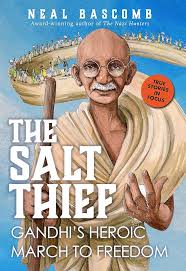2018 School Spending Survey Report
The Salt Thief: Gandhi’s Heroic March to Freedom
Scholastic Focus.
Sept. 2024.
272p.
Tr $19.99. ISBN 9781338701999.
COPY ISBN
 Gr 8 Up–Bascomb covers the facts of Mohandas Karamchand Gandhi, who welcomed hardship as a normal part of life. He even sought pain and suffering if it was for a cause he believed in. The time period from 1858 to 1947 was known as the British Raj, or rule. England ruled India and placed taxes on many goods, including salt, which was essential for life. Gandhi knew that the poorest people could not afford to purchase many things due to the greed of England. After careful consideration, Gandhi felt a peaceful protest against the salt tax was a launching point in obtaining freedom from the oppression of the British. Bascomb details the civil disobedience campaign, or satyagraha, instituted by Gandhi, his family, and closest allies. Peacefully walking 240 miles over a period of 24 days, Gandhi met with people around India, encouraging them to join in the resistance. “Gandhi and his fellow salt thieves gave the world a blueprint on how to achieve political change not by the fist, the sword, the gun, or the bomb but rather through fearless, peaceful protest.” Pencil drawings are featured at the beginning to illustrate the main people discussed and are used on occasion to punctuate the civil disobedience campaign that ensued.
Gr 8 Up–Bascomb covers the facts of Mohandas Karamchand Gandhi, who welcomed hardship as a normal part of life. He even sought pain and suffering if it was for a cause he believed in. The time period from 1858 to 1947 was known as the British Raj, or rule. England ruled India and placed taxes on many goods, including salt, which was essential for life. Gandhi knew that the poorest people could not afford to purchase many things due to the greed of England. After careful consideration, Gandhi felt a peaceful protest against the salt tax was a launching point in obtaining freedom from the oppression of the British. Bascomb details the civil disobedience campaign, or satyagraha, instituted by Gandhi, his family, and closest allies. Peacefully walking 240 miles over a period of 24 days, Gandhi met with people around India, encouraging them to join in the resistance. “Gandhi and his fellow salt thieves gave the world a blueprint on how to achieve political change not by the fist, the sword, the gun, or the bomb but rather through fearless, peaceful protest.” Pencil drawings are featured at the beginning to illustrate the main people discussed and are used on occasion to punctuate the civil disobedience campaign that ensued.
VERDICT An important addition to all library shelves to demonstrate how one person’s actions can change a nation and change the world.
RELATED
ALREADY A SUBSCRIBER? LOG IN
We are currently offering this content for free. Sign up now to activate your personal profile, where you can save articles for future viewing





Be the first reader to comment.
Comment Policy:
Comment should not be empty !!!